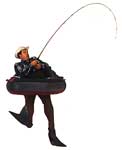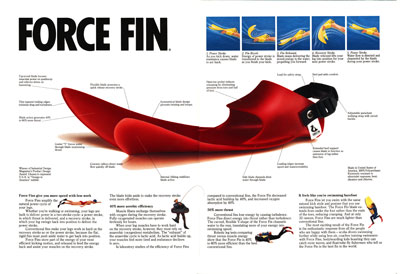Force Fins give you more speed with less work
Force Fins amplify the natural power cycle of
your legs.
Whether you're walking or swimming, your legs are built to deliver power in a two-stroke cycle: a power stroke, in which thrust is deliv ered, and a recovery stroke, in which your leg swings back into position to deliver the power stroke. ered, and a recovery stroke, in which your leg swings back into position to deliver the power stroke.
Conventional fins make your legs work as hard on the recovery stroke as on the power stroke, because the flat, rigid fins must push aside water to get back into position.
Force Fins store part of the energy of your most efficient kicking motion, and rebound to feed the energy back and assist your muscles on the recovery stroke.
The blade folds aside to make the recovery stroke
even more effortless.
40% more aerobic efficiency
 Muscle fibers recharge themselves with oxygen during the recovery stroke. Fully oxygenated muscles can operate tirelessly for hours. Muscle fibers recharge themselves with oxygen during the recovery stroke. Fully oxygenated muscles can operate tirelessly for hours.
When your leg muscles have to work hard
on the recovery stroke, however, they must rely on anaerobic (oxygenless) metabolism. The "exhaust" of the anaerobic cycle is lactic acid. As lactic acid builds up, your muscles feel more tired and endurance declines
to zero.
In laboratory studies of the efficiency of Force Fins compared to conventional fins, the Force Fin decreased lactic acid buildup by 40%, and increased oxygen absorption by 40%.
50% more thrust
Conventional fins lose energy by causing turbulence.
Force Fins direct energy into thrust rather than turbulence. The curved, flexible V-shape of the Force Fin channels water to the rear, translating more of your energy into
swimming speed.
Robotic leg tests comparing thrust versus muscle energy show that the Force Fin is 40%
to 60% more efficient than the best conventional fins.
It feels like you're swimming barefoot
Force Fins let you swim with the same natural kick style and posture that you use swimming barefoot. The Force Fin blade extends  from under the foot rather than the ends of the toes, reducing cramping. And at only 32 ounces, Force Fins are much lighter than conventional fins. from under the foot rather than the ends of the toes, reducing cramping. And at only 32 ounces, Force Fins are much lighter than conventional fins.
The most exciting result of the Force Fin is the enthusiastic response from all the people
who are happy with them - scuba divers swimming further while using less air, coaches training swimmers with Force Fins, bodyboarding kids boasting they can catch more waves, and float-tube fly fishermen who tell us the Force Fin is the best fin in the world. |
